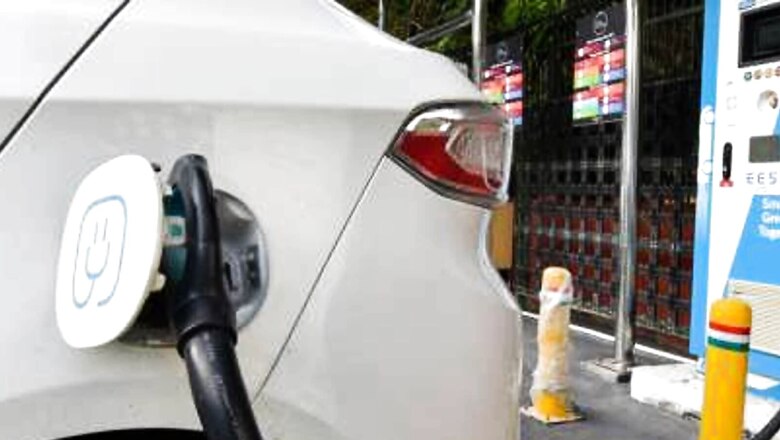
views
Governments and automakers around the world are pushing for the mass adoption of electric vehicles (EVs) as the replacement of traditional petrol-diesel vehicles to combat climate change. However, as EVs gain more popularity, even in India, a persistent question has emerged—are they truly as environmentally friendly as they claim?
While most experts agree that EVs are more environmentally friendly than traditional vehicles, they can still have environmental impacts depending on how they are charged and manufactured.
According to the United States Environmental Protection Agency (EPA), there are no tailpipe emissions from EVs but the electricity used to charge EVs may emit carbon dioxide.
The amount varies greatly depending on how local power is generated either by using coal or natural gas that emit carbon pollution, or renewable resources such as wind or solar.
Even after accounting for these electricity emissions, research shows that an EV emits fewer greenhouse gases (GHGs) than a typical new gasoline car.
The total GHGs associated with EVs could be even lower if more renewable energy sources like wind and solar are used to generate electricity.
However, according to some studies, manufacturing a typical EV produces more carbon pollution than manufacturing a gasoline car and it is due to the additional energy needed to produce an EV battery, stated the EPA.
But it should be noted that the total GHG emissions associated with manufacturing, charging, and driving an EV are typically lower than the total GHG emissions associated with a gasoline car over the life of the vehicle.
For example, Argonne National Laboratory researchers calculated emissions for both gasoline cars and EVs with a 300-mile electric range. While GHG emissions from EV manufacturing and end-of-life are higher, total GHGs for the EV are still lower than those for a gasoline car, according to their estimates.
Separately, experts also highlighted that on average, an all-electric Chevrolet Bolt emits 189 gm of CO2 per mile driven over its lifetime, while a new gasoline-powered Toyota Camry is estimated to emit 385 gm of CO2 per mile.
Are EV Batteries Problematic?
The lithium-ion cells that power most EVs rely on raw materials such as cobalt, lithium, and rare earth elements, which have been linked to serious environmental and human rights concerns and cobalt has been particularly troublesome.
Cobalt mining generates hazardous tailings and slags that can leach into the environment. Smelting, the process of extracting metals from their ores, emits sulphur oxide and other harmful air pollutants.
Here it should be noted that human rights groups warn that up to 70% of the world’s cobalt supply is mined in the Democratic Republic of the Congo, with a significant proportion in unregulated “artisanal” mines where workers dig the metal using only hand tools, putting their health and safety at risk.
Additionally, the majority of the world’s lithium is mined in Australia or from the Andean regions of Argentina, Bolivia, and Chile, where large amounts of groundwater are used to pump out brines, reducing the amount of water available to Indigenous farmers and herders.
It is believed that because of the amount of water required to produce batteries, EV manufacturing is approximately 50% more water-intensive than a traditional internal combustion engine.
Rare earth deposits, which are concentrated in China, frequently contain radioactive substances that can emit radioactive water and dust. In this case, it is noteworthy that the geo-political situation is undoubtedly a concern when it comes to dealing with China.
However, to understand the battery-related factors News18 spoke to industry insiders who gave their perspectives on EVs and batteries.
Samrath Kochar, Founder & CEO of Trontek, said in line with the government’s goal of completely transitioning to clean mobility, the automobile industry intends to gradually shift toward EVs and hybrid vehicles.
According to him, in this scenario, there is an enormous opportunity to advance clean energy resources through advanced technology and one such technological advancement that “we are witnessing is the transition from lead acid to li-ion batteries”.
He said: “While many debates about the advantages of a Li-ion battery with respect to the environment, it can’t be denied that the most crucial benefit is their low environmental impact compared to other alternatives.”
“With the number of EVs rising, the use of Li-ion batteries will ascertain a major reduction in CO₂ emissions. Further, li-ion batteries contain less toxic metals than other battery compositions, and are less hazardous for the environment,” Kochar noted.
Furthermore, he said as India moves steadily toward its 2030 SDGs, lithium-ion batteries will play a critical role in achieving this goal as soon as possible, ensuring a cleaner and greener planet.
Meanwhile, Shubham Vishvakarma, Founder and Chief of Process Engineering, Metastable Materials told News18 that although lithium-ion batteries have a reputation for being a fire hazard, much of this can be attributed to poor engineering designs and cost-cutting measures that jeopardise safety.
He further said when it comes to lithium-ion powered EVs, companies like Ather and Tesla have a proven track record of upholding the highest levels of safety and quality standards.
According to him: “As compared to an ICE vehicle, EVs shift carbon emissions from millions of individual vehicles to a single power source, even if it is fossil-fuel based, leading to better pollution management and energy efficiency at scale.
“Therefore, running an EV still has a lower overall impact on the environment and should be the way forward,” he noted.
When asked about the impact of Li-ion batteries, Vishvakarma said due to the social and environmental impact of mining activities, lithium-ion batteries are known to have some issues with the supply chain of virgin metals.
He said: “On one end of the value chain, tightening the governance of mining, with the help of organisations and authorities, is the desperate need of the hour. On the other end, governments have also realised the necessity of recycling the batteries that are already in circulation and keeping them away from ending up in landfills.”
“To this extent, advanced extraction capabilities and ‘urban mining’ can promise a recovery rate of more than 90% of the constituent materials,” Vishvakarma noted.
Moreover, he said the adoption of urban mining or battery recycling can significantly reduce the load on mining of metals, such as lithium, cobalt and nickel, by deploying chemical-free processes to meet the growing demand of Li-ion batteries for paving a cleaner future and boosting the circular economy.
Read all the Latest Auto News and Breaking News here



















Comments
0 comment